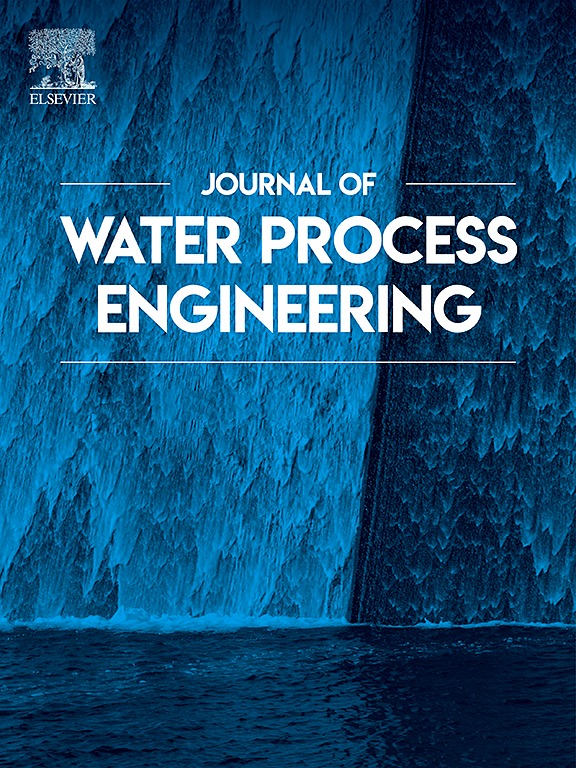One-pot synthesis of visible-light responsive BiOCl/BiOBr/g-C3N4 ternary heterojunction with excellent photocatalytic activity
IF 6.3
2区 工程技术
Q1 ENGINEERING, CHEMICAL
引用次数: 0
Abstract
BiOCl/BiOBr/g-C3N4 ternary heterojunctions were prepared via one-pot method and their photocatalytic sterilization performances for Escherichia coli (E. coli) and Staphylococcus aureus (S. aureus) under visible light illumination were investigated. The highest activity was obtained over BiOCl/BiOBr/g-C3N4 ternary composite with n(Bi): n(g-C3N4) of 1:1, which approximately inactivated 100 % of E. coli in 2 h and 87.67 % of S. aureus in 3 h. Contrast to pure BiOCl, BiOBr, g-C3N4 and BiOCl/g-C3N4, BiOBr/g-C3N4, BiOCl/BiOBr binary heterojunctions, the enhanced photocatalytic sterilization performance of the ternary heterojunction could be mainly attributed to its relatively stronger light absorption, larger specific surface area and more effective charge carriers separation. Last, the sterilization mechanism of the ternary heterojunction was discussed in detail.
具有优异光催化活性的BiOCl/BiOBr/g-C3N4三元异质结的一锅合成
采用一锅法制备BiOCl/BiOBr/g-C3N4三元异质结,研究其在可见光下对大肠杆菌(E. coli)和金黄色葡萄球菌(S. aureus)的光催化杀菌性能。BiOCl/BiOBr/g-C3N4三元复合材料中n(Bi)的活性最高:与纯BiOCl、BiOBr、g-C3N4和BiOCl/g-C3N4、BiOBr/g-C3N4、BiOCl/BiOBr二元异质结相比,三元异质结光催化杀菌性能的增强主要是由于其相对更强的光吸收、更大的比表面积和更有效的载流子分离。最后,详细讨论了三元异质结的杀菌机理。
本文章由计算机程序翻译,如有差异,请以英文原文为准。
求助全文
约1分钟内获得全文
求助全文
来源期刊

Journal of water process engineering
Biochemistry, Genetics and Molecular Biology-Biotechnology
CiteScore
10.70
自引率
8.60%
发文量
846
审稿时长
24 days
期刊介绍:
The Journal of Water Process Engineering aims to publish refereed, high-quality research papers with significant novelty and impact in all areas of the engineering of water and wastewater processing . Papers on advanced and novel treatment processes and technologies are particularly welcome. The Journal considers papers in areas such as nanotechnology and biotechnology applications in water, novel oxidation and separation processes, membrane processes (except those for desalination) , catalytic processes for the removal of water contaminants, sustainable processes, water reuse and recycling, water use and wastewater minimization, integrated/hybrid technology, process modeling of water treatment and novel treatment processes. Submissions on the subject of adsorbents, including standard measurements of adsorption kinetics and equilibrium will only be considered if there is a genuine case for novelty and contribution, for example highly novel, sustainable adsorbents and their use: papers on activated carbon-type materials derived from natural matter, or surfactant-modified clays and related minerals, would not fulfil this criterion. The Journal particularly welcomes contributions involving environmentally, economically and socially sustainable technology for water treatment, including those which are energy-efficient, with minimal or no chemical consumption, and capable of water recycling and reuse that minimizes the direct disposal of wastewater to the aquatic environment. Papers that describe novel ideas for solving issues related to water quality and availability are also welcome, as are those that show the transfer of techniques from other disciplines. The Journal will consider papers dealing with processes for various water matrices including drinking water (except desalination), domestic, urban and industrial wastewaters, in addition to their residues. It is expected that the journal will be of particular relevance to chemical and process engineers working in the field. The Journal welcomes Full Text papers, Short Communications, State-of-the-Art Reviews and Letters to Editors and Case Studies
 求助内容:
求助内容: 应助结果提醒方式:
应助结果提醒方式:


